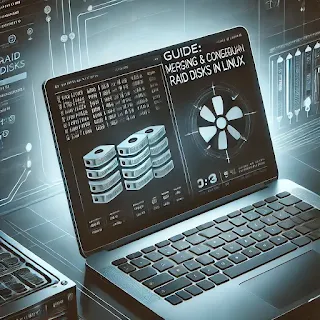Step-by-Step Guide to Merging and Configuring RAID Disks in Linux
Managing RAID disks in Linux can be a challenging yet rewarding task, especially when you need to merge and configure RAID arrays for optimized performance and reliability. This guide provides a comprehensive step-by-step approach to merging and configuring RAID disks in Linux.
Step 1: Boot Into Rescue Mode
1. Reboot your server into rescue mode. This is crucial for performing disk-level operations safely.
2. Identify the existing RAID arrays using the following command:
cat /proc/mdstat
Step 2: Assemble or Recreate the RAID Arrays
If your RAID arrays are not assembled, use the following command to reassemble them:
mdadm --assemble --scan
To create a new RAID array, for example, a RAID 1 array:
mdadm --create /dev/md0 --level=1 --raid-devices=2 /dev/sda1 /dev/sdb1
> Replace `sda1` and `sdb1` with the appropriate partitions for your setup.
Step 3: Check RAID Status
Verify the RAID array status:
cat /proc/mdstat
The output should display the RAID level, disk sync progress, and active devices.
Step 4: Partition the RAID Disk
Use `fdisk` or `parted` to partition the new RAID array if necessary:
fdisk /dev/md0
Follow the prompts to create a new partition table and partitions.
Step 5: Format the RAID Disk
Format the RAID device with a filesystem like `ext4`:
mkfs.ext4 /dev/md0
Step 6: Mount the RAID Disk
1. Create a mount point:
mkdir -p /mnt/raid0
2. Mount the RAID array:
mount /dev/md0 /mnt/raid0
Step 7: Verify Mounting
Check the available space to ensure the RAID disk is correctly mounted:
df -h
Step 8: Make the RAID Mount Persistent
To mount the RAID disk automatically at boot, add it to `/etc/fstab`:
nano /etc/fstab
Add the following line:
/dev/md0 /mnt/raid0 ext4 defaults 0 2
Step 9: Verify and Monitor RAID
To continuously monitor the RAID status:
cat /proc/mdstat
For detailed RAID status:
mdadm --detail /dev/md0
Troubleshooting Tips:
- If the RAID array is degraded, use the following to add a missing disk:
mdadm --add /dev/md0 /dev/sdX
- If swap is mistakenly enabled on the RAID disk, disable it:
swapoff /dev/mdX
This process ensures your RAID disks are merged and configured optimally for Linux. Properly managed RAID arrays provide enhanced redundancy and performance, critical for high-availability systems.


0 comments:
Post a Comment